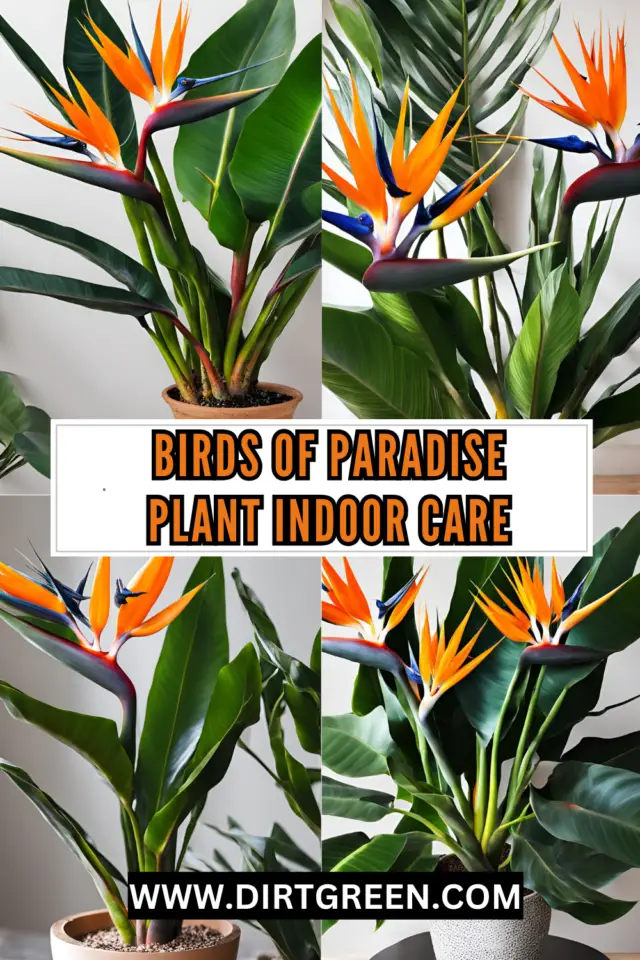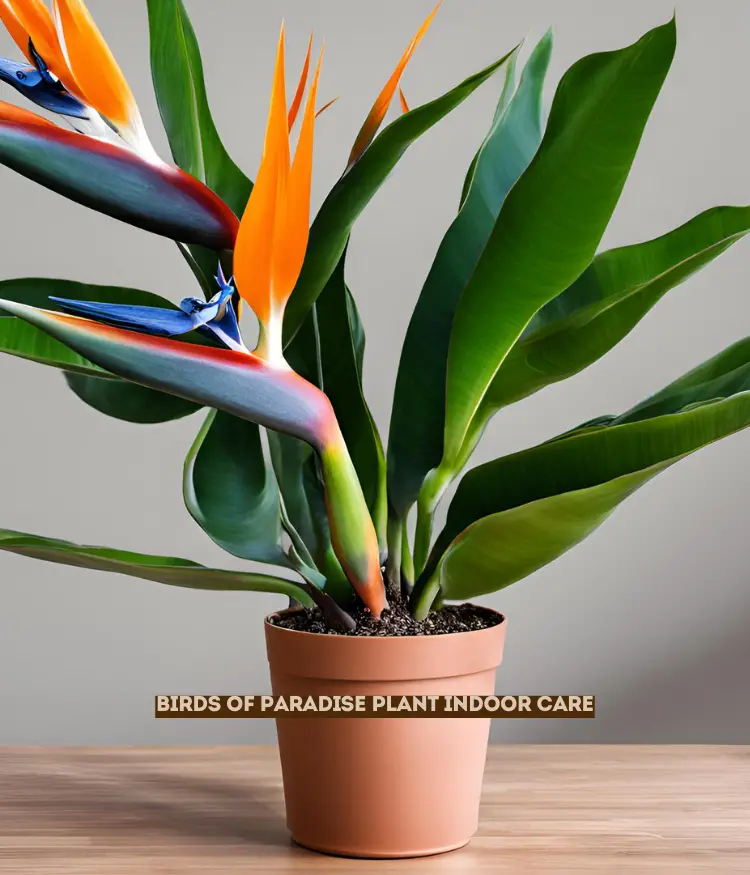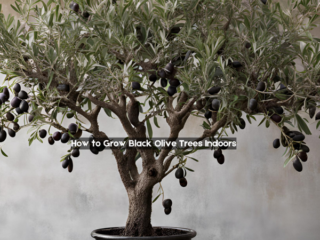The Birds of Paradise plant, Strelitzia Reginae, is a true show-stopper, with orange and blue flowers shining on top like exotic birds in flight.
Native to South Africa, these stalwart tropical plants make excellent indoor specimens and may lend a lush jungle vibe to your home decor with broad, stiff leaves and gaudy blooms.
Although it might look pretty finicky, in reality, birds of paradise are quite an easygoing house plant provided their basic needs are met.
Most will allow you to appreciate their magnificent flowers all year long, no matter how far the climate is from their place of origin.
Let’s dig deep into all that you may wish to know about keeping your birds of paradise plant thriving indoors.
Birds of Paradise Plant, Indoor Care

| Environmental Factor | Ideal Conditions |
|---|---|
| Light Exposure | Direct sunlight for 6+ hours per day; supplement with grow lights as needed |
| Temperature Range | 65-80°F during the day; No lower than 50°F at night |
| Humidity Level | 50% or higher humidity |
| Soil Mix | Fast-draining potting mix with ingredients like peat moss, perlite, bark |
| Watering Frequency | Allow top 2-3 inches of soil to dry between waterings; Water thoroughly until moisture drains from bottom of pot |
| Fertilizer Needs | Apply balanced liquid fertilizer (10-10-10 or 12-12-12 ratio) every 2 weeks during spring/summer |
| Potting | Repot every 2-3 years into a container 1-2 inches wider with fresh potting mix |
| Pruning | Remove dead/damaged leaves as needed; Cut off spent flower stalks after blooming |
Light Requirements
Birds of paradise are sun-worshippers that need lots of bright light to put on their best show.
In their native environments, they are bathed in full sun almost the entire day.
Growing them indoors, it is always a good practice to locate your plant in a sunroom or close to a big unobstructed south- or west-facing window where the sun will come through not less than 6 hours a day by direct exposure.
If you haven’t found a bright location, you may have to make up for it with artificial lighting. Place your plant under a grow light or combine fluorescent and LED bulbs to keep it under light for 12–14 hours a day at least.
Inadequate light will cause the plant to become leggy and stretched out as it strains toward the light source.
Temperature and Humidity
These tropical beauties are warm and humid. Try to keep indoor bird of paradise plants between 65 and 80°F during the day and no lower than 50°F at night.
Cold drafts can damage the foliage. The plants also prefer humidity levels of at least 50%, though higher is better if you want to avoid leaf browning.
Grouping plants together can increase ambient humidity, or you can run a humidifier near them. The leaves can be misted on a regular basis.
Soil and Repotting
Birds of Paradise like a rich but well-draining potting mix. A good blend could contain peat moss, perlite, and bark chunks.
You won’t want to use heavy mixes that can retain water, as they will cause root rot in the bird of paradise.
Remember to incorporate some slow-release fertilizer when planting to provide them with sufficient nutrients, as they are huge feeders.
These plants are generally slow-growing when kept indoors but eventually should be repotted every 2-3 years in the spring.
Select a new pot that is only 1-2 inches wider than the previous one to prevent excess soil that might remain saturated. This is also an excellent opportunity for refreshing the potting mix and pruning dead or damaged foliage.
Watering Requirements
Proper watering is essential for an indoor bird of paradise plant. Let the soil dry out a bit in between waterings, but make sure that it doesn’t dry out to the extent that the plant wilts.
Check for moisture before watering by inserting your finger into the potting mix to at least the second knuckle.
These plants should generally be watered about once a week during the warm growing season. Cut back the watering in winter when growth naturally slows.
Use room temperature water and soak the soil so that excess will run out of the bottom of the pot.
Often, yellow or dry and crispy leaf tips mean the plant is not getting enough water.
Soft, mushy leaves or stems generally mean you’ve been overdoing it with the water. Adjust your watering schedule based on the information above if you see any of these signs.
Fertilizing
You guessed it birds of paradise are heavy feeders! Give them an excellent liquid fertilizer every two weeks during the spring and summer growing seasons.
Try to find one with an N-P-K ratio of something like 10-10-10 or 12-12-12.
You can also use a diluted liquid seaweed or fish emulsion fertilizer.
Do not fertilize in winter months, as that is when growth naturally slows down. Too many nutrients at that time could do more damage than good.
Pruning and Grooming
Indoor birds of paradise plants don’t require extensive pruning, but trimming off dead or damaged leaves as needed will help keep them looking tidy.
Make clean cuts with sterilized pruners as close to the base of the plant as possible.
As leaves reach the end of their life span (1-3 years), they will typically begin to yellow and brown before dying back entirely.
Cut these off at the base of the plant as they occur. Plants will also benefit from occasional grooming to wipe dust off larger leaves with a damp cloth. This allows the plant to photosynthesize properly.
Flowering and Propagation
With their preferred growing conditions met, indoor birds of paradise will usually flower at least once per year, often more.
The flowers emerge from a stiff, upright stem in a horizontal fan of brightly colored bracts that many mistake for petals.
The actual flowers are the small, tubular blue ones poking out from within the orange bracts.
These flamboyant flowers last for a week with proper care of the plant itself and diligence in removing the faded flowers and seed pods.
Snapping off the dried flower spike will prompt the plant to produce even more blooms.
Birds of paradise can be propagated by division in the spring once their rootball has outgrown its current container.
For this, you have to take the whole plant out of its pot and, using a clean, sharp knife, divide it into two or more parts, each consisting of some part of the stems and roots.
You can report these divisions into fresh soil and in new containers, watering them well.
Diseases and Pests
Typically laid back, bird of paradise plants may sometimes be affected by:
- Yellowing leaves: This usually is due to overwatering, poor drainage, or lack of nutrients. Allow the plant to dry out more between watering and fertilization.
- Brown leaf tips or edges: Usually indicate a sign that the air is too dry and the humidity is low. Raise humidity levels around the plant.
- Inability to flower: Results from insufficient light. Move to a brighter location or use additional grow light. Also, allow the soil to dry out more in between watering.
- Pests: Occasionally, indoor plants are plagued by spider mites, mealybugs, and scales. At the first sign of insects, rinse the plant with insecticidal soap or neem oil.




